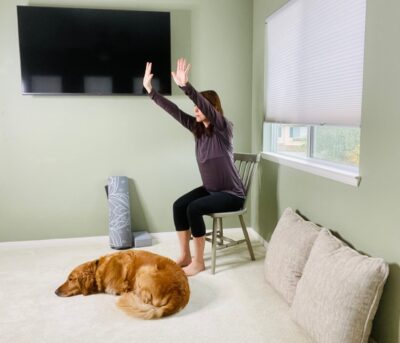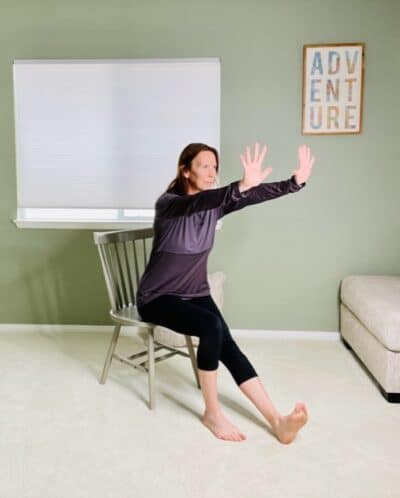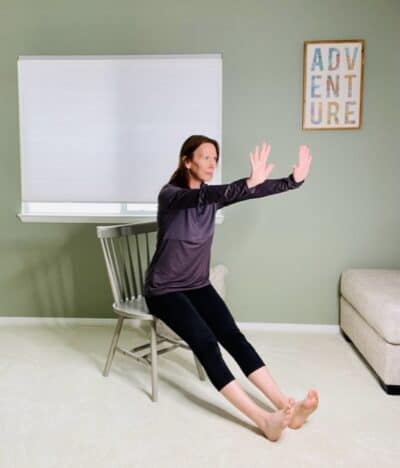Discover the Benefits of Chair Yoga: Downward Facing Dog
Even if you do not practice yoga regularly – or have not yet started a practice – you most likely have heard of Downward Facing Dog. Downward Facing Dog, or Adho Mukha Svanasana, is a fundamental pose with a multitude of benefits. But we can also enjoy all of those benefits right from the chair. With Chair Yoga, we can adapt traditional poses and practice them right from the chair- or standing with the support of the chair as well. Chair yoga seated positions offer us a gentle but effective way to integrate the therapeutic effects of yoga into our daily routine.
This post contains affiliate links. I earn from qualifying purchases. This means that I may earn a small commission should you choose to sign up for a program or make a purchase using my link. This is at no extra cost to you. I only recommend products that I truly believe are helpful. See our Privacy Policy and Disclosures.
Here, we will take a look at three variations of this wonderful pose. You can skip ahead, or if you are interested, take a quick read about some benefits of chair yoga and specifically some benefits of Downward Facing Dog practiced in the chair.
Chair Yoga – The Wonderful Benefits Of Yoga Seated Positions:
- Improves flexibility in muscles and joints, creating ease of movement in our everyday activities.
- Increases functional strength to help support our overall health and allow us to do both required functional tasks and leisure activities.
- Improves posture by strengthening muscles that support the spine and promoting awareness of our alignment.
- Reduces stress and anxiety by helping us to connect to our breath and focus on the present moment- thereby helping to promote relaxation and lower stress levels.
- Increases circulation by engaging in gentle movements that help to stimulate blood flow.
- Improves mental clarity by allowing us to engage in a mindfulness activity that can help us focus on our breathing and concentration.
- Enhances mood by encouraging us to engage in movement- which encourages proper breathing and a sense of relaxation.
- Offer us convenience and accessibility – Chair yoga is always there for us (no matter our age).
- Encourages social engagement by practicing with a group (even practicing on-line can help instill a sense of community).
And remember that it does not always have to be all or nothing- a little bit goes a long way. Just taking a few deep breaths and checking in with our posture and how we feel can have tremendous benefits for our overall health and well-being. Integrating chair yoga into our routine can offer these benefits and more, making it a versatile and effective form of exercise and relaxation. Keep reading for a few benefits of the Seated Downward Facing Dog Pose.
Benefits Of Downward Facing Dog:
- Engages the core
- Helps us connect to the breath
- Stretches the shoulders, wrists, and/or hamstrings
- Helps to strengthen the lower body
- Boosts energy
- Calms the mind by putting our focus on the breath
Now, if you would like to give this wonderful pose a try, take a look at the simple progression of this pose. Of course, there are many variations that we can take and feel free to add in any movements that feel right to you. As always, take the modifications that you need. You may always choose to clasp the opposite hand to the opposite elbow and lift the arms to take strain off the shoulders. If you would like a standing version, you can take a look here: 5 Standing Chair Yoga Poses For Beginners.
Downward Facing Dog Variations: 3 Chair Yoga Positions For The Body And Mind
As always, it is recommended to consult with your healthcare provider before starting this or any exercise program. Always listen to your body and do what is right for you today. Never force or strain. Always stop this or any exercise immediately if you experience pain, shortness of breath, or dizziness. For any pose variation, eliminate the wrist extension if that is not right for you.
We will look at these 3 variations that are practiced seated in the chair. The first variation can be practiced seated all the way back in the chair. Variation 2 and 3 are best practiced seated forward a few inches- but check out the modifications below! For all 3 variations, we will start in our Mountain Pose
- You may choose to sit all the way back in your chair, or sit forward a few inches in your chair
- Feet are supported firmly on the ground (you may place yoga blocks or sturdy thick books under the feet as needed)
- Ankles in line with the knees as best you can
- Lengthen from the base of the spine to the crown of the head
- Core is engaged
- Chest is open and shoulders are relaxed down away from the ears
1. Downward Facing Dog With Knees Bent

- Begin in your Mountain Pose with the arms resting by the sides, palms facing the body
- Inhale to lengthen the spine
- Exhale to hinge forward at the hips, spine stays long (don’t round the back)
- Inhale to raise the arms up (as far as comfortable)
- Exhale to rotate the shoulders and face the palms down
- Inhale to extend the wrists and bring the fingers back toward the face
- Stay here for 2-3 breaths or as desired
- On an exhale, bring the wrists back to neutral, rotate the palms to face one another, hinge at the hips back to center as the arms release back down by the body
- Repeat 1-2 times or as desired
2. Downward Facing Dog – One Knee Extended

- Begin in your Mountain Pose with the arms resting by the sides, palms facing the body
- (If your feet are resting on blocks or books, you will need one block to be placed forward several inches)
- Straighten one knee and rest the heel on the floor
- Inhale to lengthen the spine
- Exhale to hinge forward at the hips, spine stays long (don’t round the back)
- Inhale to raise the arms up (as far as comfortable)
- Exhale to rotate the shoulders and face the palms down
- Inhale to extend the wrists and bring the fingers back toward the face
- Stay here for 2-3 breaths or as desired
- On an exhale, bring the wrists back to neutral, rotate the palms to face one another, bend the extended knee, and hinge at the hips back to center as the arms release back down by the body
- Repeat 1-2 times or as desired
Modification: If seated all the way back in your chair, you may choose to lift one foot and straighten the knee with the toes pointed toward the sky.
3. Downward Facing Dog- Both Knees Extended

- Begin in your Mountain Pose with the arms resting by the sides, palms facing the body
- ( If your feet are resting on blocks or books, you will need to place them both several inches forward)
- Straighten one knee at a time and rest the heels on the floor
- Inhale to lengthen the spine
- Exhale to hinge forward at the hips, spine stays long (don’t round the back)
- Inhale to raise the arms up (as far as comfortable)
- Exhale to rotate the shoulders and face the palms down
- Inhale to extend the wrists and bring the fingers back toward the face
- Stay here for 2-3 breaths or as desired
- On an exhale, bring the wrists back to neutral, rotate the palms to face one another, bend one knee and then the other, and hinge at the hips back to center as the arms release back down by the body
- Repeat 1-2 times or as desired
Modification: If seated all the way back in your chair, you may choose to lift both feet and straighten the knees with the toes pointed toward the sky.
I hope that you enjoyed these three variations. Let me know what you think in the comments below!
Gentle Reminder To Listen To Your Body
Listening to your body during exercise is essential for maximizing benefits and preventing injury. By tuning into our body’s signals, we can tailor our movements to meet our individual needs, thus improving our overall well-being. This mindful approach can help us to recognize when to push harder or when to rest, ensuring that we are challenging ourselves without overdoing it. Additionally, listening to our body promotes a deeper connection with our physical and mental states, leading to more effective stress management and increased enjoyment of our exercise routine. This practice not only supports long-term fitness goals but also fosters a positive relationship with our body, encouraging a balanced and sustainable approach to health and wellness.
For more mindfulness practices, you may be interested in this book: Practicing Mindfulness: 75 Essential Meditations
Want More?
Take a look at the 21 Day Mindfulness Challenge for a gentle introduction to mindfulness practices.
You may also be interested in these 5 yoga seated positions of the chair yoga Warrior II Pose.
If you would like a simple chair yoga challenge (three poses a day for seven days) you can take a look here
Or, take a look at these 3 Full Body Chair Yoga Poses
You may also be interested in my daily journal notebook: Fill Your Cup
Or, my daily habit tracker notebook: You Are Awesome
I invite you to sign up for the Monthly Email Newsletter to stay up to date on the latest blog posts and videos.
Or take a look at The Peaceful Chair Etsy Shop for health and wellness related printable pages and more.
Namaste!
Disclaimer: The Peaceful Chair and thepeacefulchair.com strongly recommends that you consult with your physician before starting this or any exercise program.The information provided on this website is for informational purposes only and is not to be used in place of medical advice or information from your healthcare provider. Neither The Peaceful Chair, the peacefulchair.com, nor any of its contributors shall be held liable for any improper or incorrect use of the information described and/or contained herein and assumes no responsibility for anyone’s use of the information contained in any links, videos, or any content on this website.

Leave A Comment